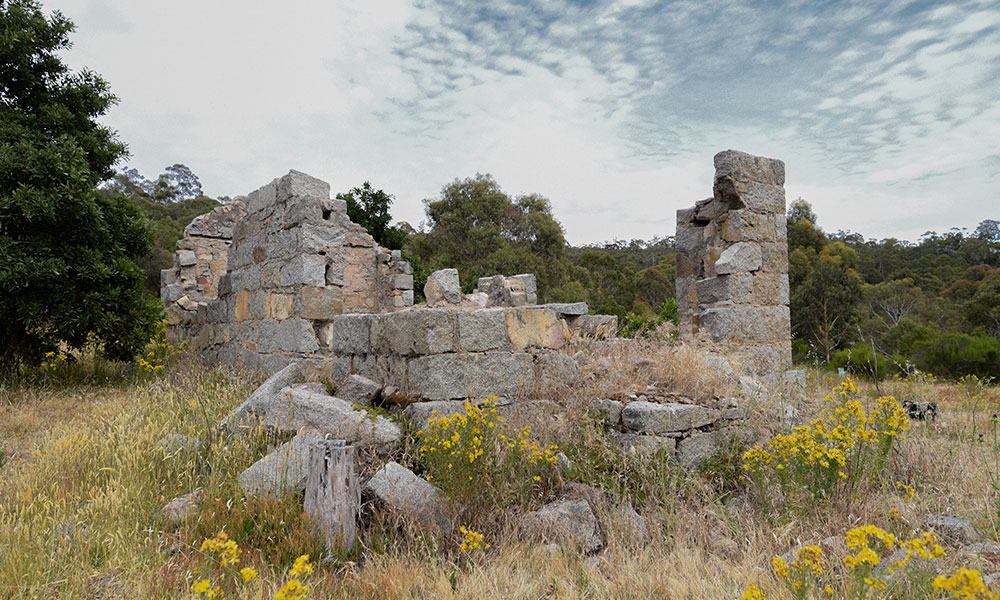The Former Mount Alexander Silkworm Farm (H1348) is the only documented site with substantial evidence of silkworm farming in Victoria, and one of only two in Australia.
High up on Mount Alexander are the crumbling walls of two stone buildings. These ruins are all that remains of a silkworm farm that dates from the 1870s. Orbe Farm was a short lived enterprise. The stone remnants stand as a monument to a pioneering business enterprise run by women.
In 1873 the Victorian Ladies Sericultural Company formed in Melbourne. It had an all-women board of directors and only female shareholders had voting rights. Sarah Bladen Neill was the 'energetic and indefatigable' driving force of the company. Mrs Neil claimed that 'not even in America has there been a company formed entirely of women.'
Silk was a valuable commodity, and a luxury alternative to cotton and wool. Sericulture is the rearing of silkworms and production of raw silk from their cocoons. Mrs Neil was convinced that silk production could become a major Australian industry.
The company was granted 250 hectares on Mount Alexander as the site of Orbe Farm. They planted 35,000 mulberry trees (silkworms eat the leaves), and built a breeding shed to house the worms.
As well as developing a profitable business, the company had philanthropic goals. They wanted to build an industry which could provide women with work and an income. They offered training in sericulture to 'that class of persons now kept in compulsory idleness and dependence' - in other words, unmarried women from middle-and upper-class families. The trained women would then instruct women of the lower classes. Mrs Neil predicted that 'many parents might then consider their daughters a mine of wealth, which may perhaps never have struck them before'.
Many people and organisations supported the enterprise, contributing trees, cuttings and silkworm eggs. Supporters included the Victorian Acclimatisation Society and Dr Mueller of the Botanic Gardens.
The life cycle of a silkworm is about 7 weeks from hatching to cocoon. During this time it does little but eat mulberry leaves. In the company's first year, the thousands of silkworms bred at the farm ate about 16 kilograms of leaves per day.

Unfortunately, the site was beset by problems from the start. Frost and then baking summer heat damaged the young trees. The location of the farm was far from ideal. The site was steep and hard to access, and the soil was poor and strewn with granite boulders.
All Mrs Neill’s zeal and eloquence could not produce enough leaves to feed the silkworms. After three failed seasons the company sought a ‘more favourably situated’ site.
In 1877 the company set up a new farm at Corowa, on the NSW side of the Murray River. Of the 35,000 mulberry trees planted at Mount Alexander, only 5,000 survived for relocation. The enterprise failed to thrive. Some critics believed that a ‘directorate of ladies will not command the confidence which it is necessary to inspire in order to attract sufficient capital’. Others recognised the folly of trying to breed silkworms before having a well-established mulberry plantation.
Sarah Bladen Neil was tireless in her promotion of sericulture as a 'woman's industry'. She petitioned government ministers, wrote pamphlets and gave lectures until her death in 1881. ‘Before long,’ she wrote ‘I trust the fascinations of the silkworm will rival those of the sewing-machine…’
By one account, Mrs Neill had ‘almost enough energy to set the Murray on fire’. Despite her efforts, sericulture in Australia never grew beyond a cottage industry.
The former silkworm farm is in Mount Alexander Regional Park, a short walk from the parking area. All that remains are the stone ruins - not a single mulberry tree survived.
Page last updated: 01/07/24